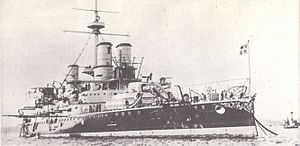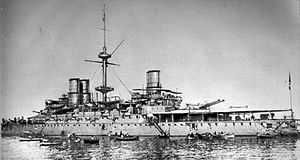Italian battleship Sardegna
 Sardegna | |
| Career (Italy) | |
|---|---|
| Name: | Sardegna |
| Namesake: | Sardinia |
| Builder: | La Spezia Naval Shipyard |
| Laid down: | 24 October 1884 |
| Launched: | 20 September 1890 |
| Completed: | 16 February 1895 |
| Struck: | 4 January 1923 |
| General characteristics | |
| Class and type: | Re Umberto-class pre-dreadnought battleship |
| Displacement: | 13,641 long tons (13,860 t) normal 15,426 long tons (15,674 t) full load |
| Length: | 428 ft 10.5 in (130.7 m) |
| Beam: | 76 ft 10.5 in (23.4 m) |
| Draft: | 29 ft (8.8 m) |
| Installed power: | 22,800 ihp (17,002 kW) |
| Propulsion: | 2 shafts, vertical triple expansion steam engines, 18 cylindrical boilers |
| Speed: | 20.3 knots (23.4 mph; 37.6 km/h) |
| Range: | 4,000–6,000 nautical miles (7,408–11,112 km) at 10 knots (19 km/h; 12 mph) |
| Complement: | 794 |
| Armament: | 2 × 2 - 13.5-inch (343 mm)/30 guns 8 × 1 - 6-inch (152 mm)/40 guns 16 × 1 - 4.7-inch (119 mm) guns 20 × 1 - 57-millimeter (2.2 in) six-pounder guns 10 × 1 - 37-millimeter (1.5 in) guns 5 × 1 - 17.7-inch (450 mm) torpedo tubes |
| Armor: | Belt and side: 4 in (102 mm) Deck: 3 in (76.2 mm) Barbettes: 13.75 in (349 mm) Conning tower: 11.88 in (302 mm) |
Sardegna was a Re Umberto-class pre-dreadnought battleship built for the Royal Italian Navy (Regia Marina) in the 1880s. She was the third ship of her class laid down, but the second finished.
Description
General characteristics



Sardegna was 411 feet 9 inches (125.5 m) between perpendiculars and 428 feet 10.5 inches (130.7 m) long overall. She had a beam of 76 feet 10.5 inches (23.4 m) and a draft of 29 feet (8.8 m). Normally she displaced 13,641 long tons (13,860 t) and displaced 15,426 long tons (15,674 t) at full load. She was built with a ram bow.[1]
Propulsion
Sardegna was the first Italian warship fitted with two three-cylinder vertical triple expansion steam engines with a total designed output of 22,800 indicated horsepower (17,002 kW). Eighteen cylindrical boilers provided steam to the engines. On trials, the ship had a top speed of 20.3 knots (37.6 km/h; 23.4 mph). She carried enough coal to give her a range of 4,000–6,000 nautical miles (7,408–11,112 km) at 10 knots (19 km/h; 12 mph). She had three funnels, but, unusually, the two forward funnels were side-by-side.[1]
Armament
Sardegna 's main armament consisted of two pairs of breech-loading British BL 13.5-inch (343 mm) Mk I–IV 30-caliber guns mounted in twin barbettes fore and aft. These guns had a maximum elevation of 13.5° and could depress to -3°. They fired a 1,250-pound (570 kg) shell at a muzzle velocity of about 2,016 ft/s (614 m/s) to a range of about 11,950 yards (10,930 m) at maximum elevation. They had a rate of fire about 2–3 minutes per round.[2]
The eight 6-inch (152 mm) 40-caliber guns were mounted on pivot mounts on the upper deck. They were protected by gun shields 2 inches (51 mm) thick. The anti-torpedo boat armament consisted of sixteen 4.7-inch (120 mm) 40-caliber guns. Twelve of these were in casemates on the main deck and four were mounted in the fore and aft superstructures, protected by gun shields. Twenty 57-millimeter (2.2 in) six-pounder and ten 37-millimeter (1.5 in) one-pounder guns were mounted in the superstructure. Sardegna carried five 17.7-inch (450 mm) torpedo tubes, all above water.[1]
Armor
Sardegna 's steel armor was made by the French company Schneider et Cie. The side of the hull between the barbettes was completely protected with a maximum thickness of 4 inches (102 mm) of armor. The barbettes were 13.75 inches (349 mm) thick and she was the only ship of her class to receive 4-inch gun shields for her main armament. The conning tower had 11.8 inches (300 mm) walls. The armor deck was 3 inches (76 mm) thick.[1]
Service
Sardegna was named after the island of Sardinia. She was built by the La Spezia Naval Shipyard. She was laid down on 24 October 1885, launched on 20 September 1890, and completed on 16 February 1895. She participated in the Italo-Turkish War, where she used an airplane to spot for her guns.[3] She was stricken on 4 January 1923.[1]
Footnotes
- ↑ 1.0 1.1 1.2 1.3 1.4 Gardiner & Gray, p. 342
- ↑ "Britain 13.5"/30 (34.3 cm) Marks I, II, III and IV". Navweaps.com. 19 May 2009. Retrieved 20 March 2010.
- ↑ Michael Paris, "The First Air Wars - North Africa and the Balkans, 1911–13", Journal of Contemporary History, Vol. 26, No. 1 (Jan., 1991), pp. 97–109.
References
- Fraccaroli, Aldo (1970). Italian Warships of World War I. London: Ian Allan. ISBN 978-0-7110-0105-3.
- Gardiner, Robert; Gray, Randal, eds. (1979). Conway's All the World's Fighting Ships: 1860-1905. Annapolis: Conway Maritime Press. ISBN 0-85177-133-5.
External links
| ||||||||||